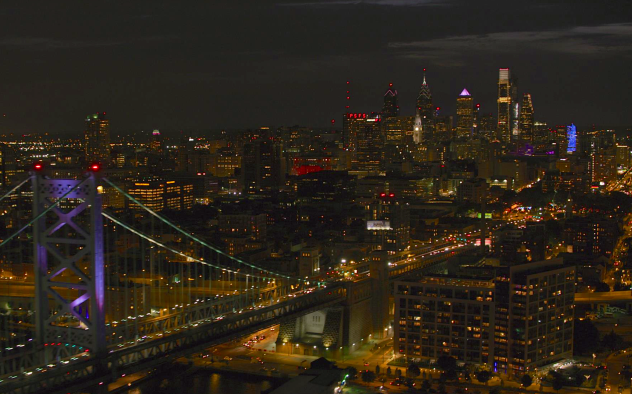Big city skyline going dark to save migrating birds
Every spring and fall, billions of birds migrate through the skies over the United States, mostly during the night. Increasingly, the birds making this mass migration are forced to deal with the threat of light pollution.
Philadelphia has become the latest city to commit to turning out the lights during peak bird migration periods in the spring and fall.
"A huge, huge amount of bird movement happens at night," Andrew Farnsworth told AccuWeather in a recent interview. Farnsworth is a senior research associate at the Cornell Lab of Ornithology. He has studied weather radar for decades. Stripped of its meteorological data, the radar reveals a vast amount of information about bird migration. He is also the lead biologist on the BirdCast Project, a collaboration between ornithologists and computer scientists to forecast bird migration.
Farnsworth said birds travel at night because they use constellations to guide their travels. However, artificial lights from tall city buildings can disorient birds and cause them to collide with buildings and windows.
 |
Andrew Farnsworth, PhD. Senior Research Associate, Cornell Lab of Ornithology |
Light attracts migrating birds and can cause any number of disruptions to their flight, including confusing their navigation systems and causing them to circle buildings repeatedly. This can lead to the birds ultimately exhausting themselves, which can make them vulnerable to collisions with buildings and windows.
Birds will often think they can fly through or into any buildings with large areas of transparent glass in an attempt to get to attractive lighting, plantings, fountains or even toward a place that looks like it could provide shelter.
Similarly, birds will fly toward images of trees, plants or sky that they see in the reflective glass surfaces of buildings. An estimated 365 million to 988 million birds die in collisions with buildings annually, including a number of species facing conservation threats.
📡 Key West radar has had a busy night, but not because of weather! The most impressive display of migratory birds so far this year occurred overnight. This product shows biological targets in green/yellow flying north over the Keys. Showers/rain are depicted in darker blues. 🐦 pic.twitter.com/V2PJfucxJA
— NWS Key West (@NWSKeyWest) February 17, 2020
It was the Cornell Lab of Ornithology and New York City Audubon that realized turning off bright lights helps birds move on within minutes when they studied the annual 9/11 light memorial in downtown New York City. Each year, hundreds of birds flock to the memorial's towering beams. Researchers realized turning them off for up to 30 minutes at a time significantly decreased the number of birds in the area.
It's not only a tragic loss of bird life that is at stake. Migratory birds are a critical part of the balance of nature that affects all facets of an ecosystem. Plants and animals above and below them on the food chain depend on birds for survival. Birds pollinate plants, disperse seeds and control insects and other pests. Many of the world's bird populations are in serious decline, facing increasing threats including loss of habitat, hazards of man-made structures as well as air, soil and water pollution.
 |
NASA Earth Observatory images by Joshua Stevens, using Suomi NPP VIIRS data from Miguel Román, NASA's Goddard Space Flight Center |
The solution to deaths as a result of light pollution is simple: Turn off unnecessary lights during critical migration periods. Audubon's "Lights Out" program is a national effort to reduce this problem, and Philadelphia is the latest city to join the more than 30 cities and municipalities who have adopted Lights Out, including Boston, Chicago, New York City and Atlanta, and all state-owned buildings in the entire state of New York.
Building owners and property managers who follow Lights Out protocol turn off as many non-essential exterior and interior lights as possible so they don't confuse birds as they fly through urban landscapes at night. The darkness provides a safe passage between their nesting and wintering grounds.
 |
The yellow-rumped warbler (Setophaga coronata) is a regular North American bird species with the population concentrating in the continent's northern parts during the breeding season and migrating southwards to southern North and Central America in winter. Photo Credit: Wikipedia |
Philadelphia joined the Lights Out effort this month as a result of a coalition of groups including the Audubon Mid-Atlantic, several local chapters along with the Academy of Natural Science and the Delaware Valley Ornithological Club. According to the Audobon, Bird Safe Philly began with a mass kill on a cloudy night in Philadelphia last year.
On Oct. 2, 2020, more than 1,000 migrating birds collided with buildings within a small area in downtown Philadelphia during fall migration. It was the worst such event in the region in more than 70 years.
Jason Weckstein, the associate curator of ornithology at Drexel University's Academy of Natural Sciences, told AccuWeather that the weather combined with the bright lights from city skyscrapers created a perfect storm.
 |
Philadelphia skyline. Photo credit: Getty Images |
"Conditions were perfect for a heavy migratory flight and imperfect given that there was a low ceiling of clouds and rain," Weckstein said. "That, in combination with Philly's bright city lights, was a disaster for many fall migrant birds winging their way south."
Audubon Pennsylvania's program manager for urban conservation, Keith Russell told Audubon.org, "Finding hundreds of dead and injured birds on a single morning was a gruesome and overwhelming experience. But one that has motivated those of us who witnessed it to push even harder for new measures that will reduce hazards for migratory birds in the Philadelphia region."
Lights Out Philly officially begins on April 1 and lasts until May 31, with the fall season running from Aug. 15 through Nov. 15. All buildings participating are asked to turn off lights between midnight and 6 a.m. The program is a win-win for birds and cities. As BirdCast notes, the Lights Out initiative will do more than save birds -- it will also save energy and money. The Environmental Protection Agency highlights energy as the largest operating expense for commercial buildings.
 |
Andrew Farnsworth said he looks forward to a day when we're connecting science from weather radar to a bigger picture and conservation actions in real-time.
Farnsworth said there is a pilot project underway in Texas in which developers are trying to create a smartphone app that uses a forecast model based on 23 years of radar data that will allow for the input of weather variables. The goal is for the app to use that information to predict where, when and how many birds are going to be aloft and then connect that to a push alert sent to an app user that advises, "This is a night when it's really important to turn off lights in urban areas."
He believes programs like Lights Out can begin to readjust the typical human perspective that lighting up the night is technological progress.
 |
More than 1,000 birds, including these, were killed by accidentally striking windows and buildings in Philadelphia on Oct. 2, 2020. Photo credit: Stephen Maciejewski |
Farnsworth sees this as an important step "to get people over the hump" and start considering the idea that "maybe not all light at night is as good as I thought it was."
He suggested that people may need to rethink ideas around human progress being associated with nighttime illumination in major cities. "Maybe," he mused, "you just turn off the lights on one particular night, and that's your stepping stone to much broader elimination of that light pollution situation."
Click here to find out how you can make a difference. You can see live bird migration maps here.
Keep checking back on AccuWeather.com and stay tuned to the AccuWeather Network on DirecTV, Frontier, Spectrum, FuboTV, Philo, and Verizon Fios.







